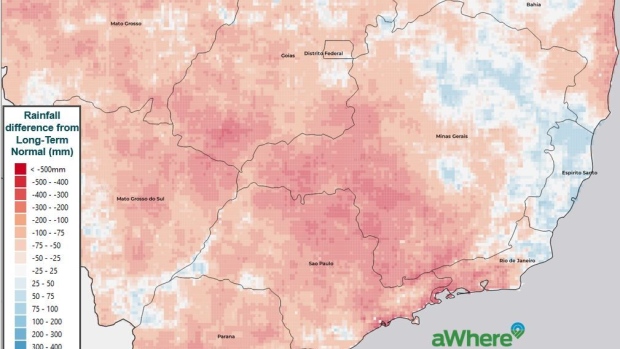May 17, 2021
World’s Oranges, Coffee at Risk as Brazil Runs Out of Water
, Bloomberg News

(Bloomberg) -- Brazil, the world’s biggest exporter of coffee, sugar and orange juice, just had a rainy season that brought hardly any rain.
Soils are parched and river levels are low in the nation’s Center-South region, a powerhouse of agricultural output. The drought is so severe that farmers are worried they’ll run out of the water reserves that help keep crops alive over the next several months, the country’s dry season.
Mauricio Pinheiro, 59, started irrigating his arabica-coffee crops in March, two months earlier than normal, after his 53-hectare plantation got less than half of the rain it needed. He’s using so much water for the plants that there isn’t enough left for his home. In order to keep the showers and faucets running, he’s had to search for another well.
“My irrigation reservoir is drying up now -- that usually happens in August,” said Pinheiro, who lives in Pedregulho in the Alta Mogiana region, in Sao Paulo state. “I’m really concerned about running out of water in the coming months.”
The prospect of withering orange trees and coffee plants is coming at a time when agricultural crops are rallying to multiyear highs, which has fanned fears of food inflation. Higher food costs may exacerbate hunger, a problem around the globe that the Covid-19 pandemic has made more acute. Coffee and raw-sugar contracts on the ICE Futures exchange in New York have already touched four-year highs.
If even irrigated areas can’t get enough water, Brazil’s coffee and orange output may decline for a second year in a row. Brazil’s current orange crop shrunk 31% from the previous season, the most in 33 years, and production of arabica coffee, the high-end kind used by chains like Starbucks Corp., is also dropping sharply.
Rainfall was disastrously low for many areas in Sao Paulo and Minas Gerais from January to April, said John Corbett, Chief Executive Officer at aWhere Inc. Over the next 15 days, most of Brazil is projected to remain drier than normal.
While a dry spell is typical for this time of year in Brazil, it’s expected to last longer than usual, adding to concerns. Regular rains will return to the region between October and November, instead of September, said Celso Oliveira, a meteorologist at Somar Meteorologia.
About 30% of Brazil’s orange crop and 15% of arabica coffee fields are irrigated.
“The levels of rivers and lakes has been very concerning,” said Regis Ricco, director at Minas Gerais-based RR Consultoria Rural.
Francisco Sergio de Assis, a coffee grower in Monte Carmelo, a municipality in the Cerrado region of Minas Gerais, started irrigating his fields a month early, and doesn’t think his water reservoirs will last if it doesn’t rain by September.
The situation is becoming critical for orange groves. Emerson Fachini, an orange farmer who cultivates 45 hectares (11 acres) in Palestina municipality in Sao Paulo state, said he’s had irrigation systems turned on for most of the time since January.
“Water reservoirs are drying up, depleted just ahead of the dry season,” Gilberto Tozatti, of Sao Paulo-based GCONCI-Group Citrus Consulting, said by phone. “The situation is affecting most of Sao Paulo state and still harming next season’s crop.”
©2021 Bloomberg L.P.


